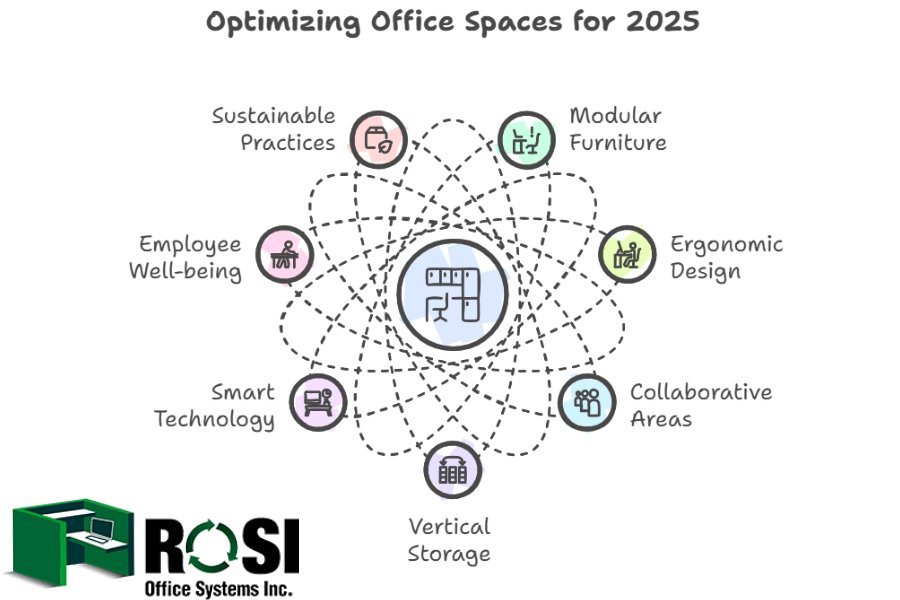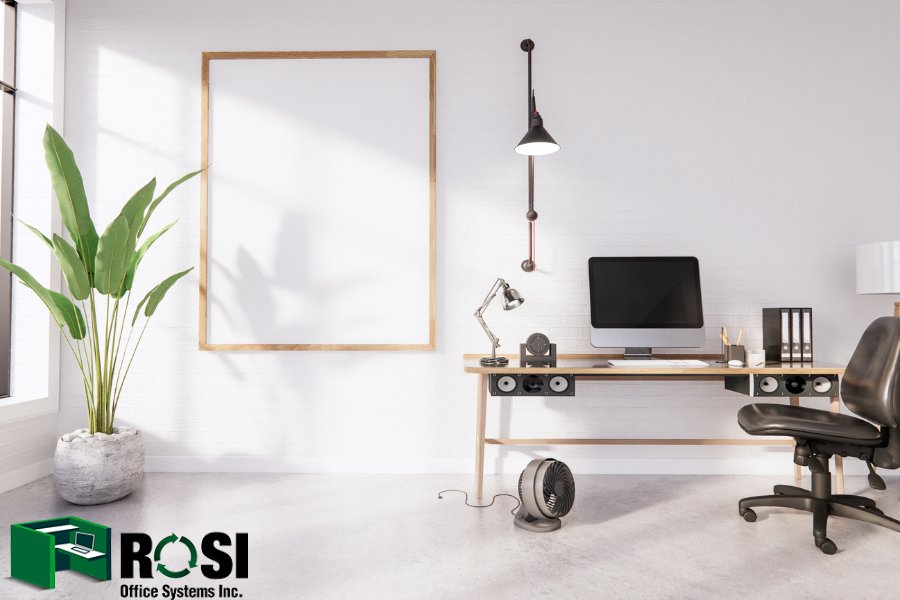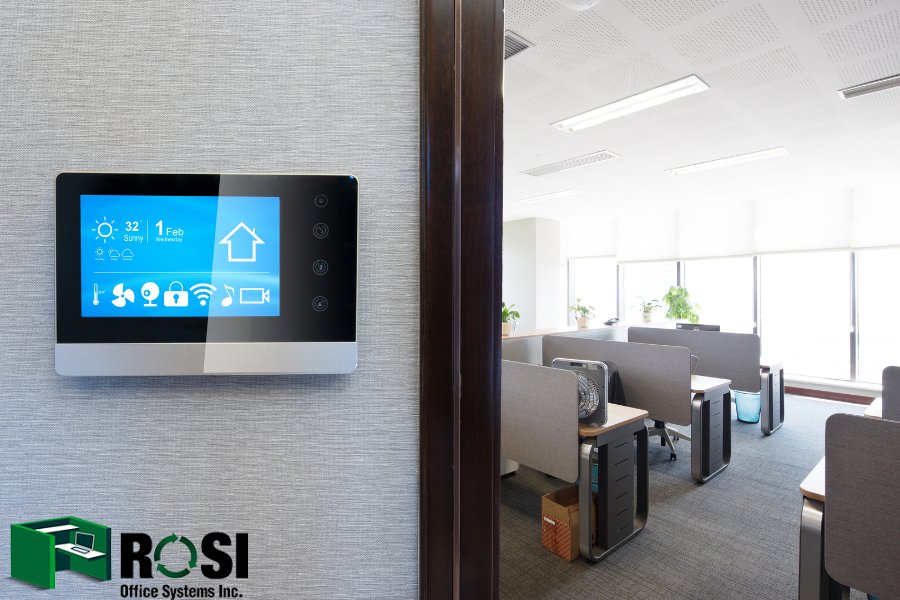
As businesses change and grow in 2025, as well as the increase in hybrid and remote work models, many businesses need to use their workspace more efficiently and effectively.
They will need to optimize their workspace to make it a flexible and productive space.
Now the question is: how to optimize office space in 2025?
Optimize office space by using modular furniture for flexibility, ergonomic desks for comfort, and collaborative areas to encourage teamwork. Incorporate vertical storage, multi-functional furniture, and smart technology to maximize efficiency. Create open spaces for creativity and quiet zones for focus, balancing productivity and comfort.
In this article, we suggest 7 effective solutions to optimize your workspace to increase productivity and cost-effectiveness.
If you want to have a modern, dynamic, and future-proof workspace, don’t miss these solutions!
What is office space optimization?
Optimizing office space means designing and using space in a way that maximizes productivity and efficiency while meeting employee needs and reducing costs.
In this process, business owners try to utilize every square meter of their office space in a way that helps them achieve business goals and employee satisfaction.
By using data-driven insights and solutions, you can make the best use of available spaces.
You can also create an optimal workspace by changing layouts, reducing unnecessary costs caused by unused space, and improving productivity through better design of work areas.
To optimize space, the first step is to understand how employees interact with the work environment.
For example, identifying which spaces are best suited for individual work, group work, or relaxation can help inform decisions.
Optimizing office space is not just about using physical space effectively, but also about designing environments that increase employee satisfaction and well-being and the overall efficiency of the organization.
By leveraging technology and accurate data, it is possible to achieve an ideal space that both contributes to business goals and ensures employee well-being.
You Might Also Enjoy: Top 10 Places To Buy Office Furniture In Houston [2025 Update]
1. Adopt Flexible Office Layouts
One way to optimize your office is to use a flexible layout.
This layout allows businesses to adjust the space to suit their employees’ needs.
This type of layout not only saves space but also increases collaboration and interaction between people.
One of the best ways to create an optimal space is to create activity-based workspaces.
In these spaces, instead of each person having a fixed space, different sections are considered for specific activities.
For example, shared office desks for teamwork, private rooms for doing tasks that require concentration, and rest and creative spaces for idea generation and information exchange are types of activity-based spaces.
Hot desking is also a great idea for creating an optimal space in offices.
Where no fixed employee is assigned to each desk and people can choose a desk or workspace according to their needs.
This method helps companies avoid creating unnecessary individual spaces and encourages employees to interact more.
The benefits of using flexible office layouts, in addition to optimal use of space, include reduced office rental and equipment costs, increased interaction and collaboration between teams, and greater flexibility for remote and hybrid employees.
2. Design Customizable Zones
To experience an efficient workspace, it is better to design different sections according to the needs of employees.
In modern workplaces, the needs of employees and businesses are constantly changing.
Some businesses are very dynamic and need spaces for teamwork and collaboration.
On the other hand, some employees need to work individually and in a quiet, focused environment.
Therefore, creating multifunctional and flexible spaces that can adapt to these needs is one of the best ways to optimize space, increase productivity, and improve the work experience.
In flexible businesses, conference rooms are no longer just fixed rooms with traditional layouts, but in modern design, the rooms are multi-purpose and variable.
An optimal and successful workspace should strike a balance between collaborative spaces and quiet areas for focused work.
Today, modern offices include dedicated zones for different activities.
These zones include the following types:
- Collaboration spaces: These spaces, such as meeting rooms and discussion halls for exchanging ideas and information, should have an open and flexible layout with group tables and benching desks.
Also, the use of interactive whiteboards and advanced systems to facilitate teamwork, and spaces with comfortable furniture for exchanging information are among the features of these environments.
- Quiet spaces: Designated zones with quiet and peaceful spaces for employees who need to perform their tasks without distractions.
These spaces can be designed with private office cubicles with soundproof walls.
- Rest zones: It is necessary for employees who need to recover and drink coffee, which increases their productivity mentally.
3. Integrate Hybrid Work Models
Today, new working methods such as hybrid working have become very popular in businesses, and this opportunity can be used to optimize the workspace.
In a hybrid work model, a number of employees can work remotely at times, thus reducing the need to allocate space for dedicated desks.
In a hybrid workplace, shared workspaces such as workstations and office benching systems can be designed between different teams instead of fixed desks.
You can also design multi-purpose workspaces to use for group work, individual work, or meetings.
If you want to use a hybrid work solution to optimize your workspace, you must also have the necessary technological infrastructure so that there is no interference in the work process.
One of the most effective ways to optimize office spaces and facilitate collaboration between teams is to use cloud-based solutions.
These technologies allow employees to collaborate online and from anywhere, without having to be physically present in the office.
In this case, employees can easily share documents with each other, eliminating the need for physical paper and documents and a place to store them.
4. Use Modular Furniture and Multi-Functional Spaces
One of the best solutions for optimizing workspace is to use modular office furniture and design multipurpose spaces.
In this way, businesses can easily and quickly change their workspace according to their needs.
On the other hand, by using modular furniture, you can make the most of every square meter of workspace.
Modular office furniture includes flexible workstations, movable and height-adjustable partitions, standing desks, modular conference tables, folding chairs and tables, and office benching systems.
Using movable furniture, a meeting room can be transformed into a collaborative work or break space when needed.
Also, if you are in Houston, instead of buying office furniture, you can rent it from companies active in this field of office furniture rental, such as ROSI Office Systems Inc.
This saves costs and allows you to adjust the space based on current needs.
It also allows you to change the type and amount of furniture without additional costs as the organization’s needs change.
5. Use Smart Technology for Space Management
We live in a smart world and can use most of our office space by making it smart.
By integrating technologies like the Internet of Things (IoT), artificial intelligence, and automated environmental control systems, you can transform the office into a smart space that is more efficient, comfortable, and sustainable.
In this workspace, using smart sensors, it is possible to determine which parts of the office are used more or less.
For example, a conference room may be less used in the mornings, so it can be used for other activities.
Data analytics helps businesses make the most of their space.
Light and temperature sensors can also turn off lights and lower temperatures when a space is unoccupied to reduce energy consumption.
By implementing these technologies, the workplace will become a smart, efficient space that adapts to employee needs, which in addition to reducing costs, will also increase productivity.
6. Maximize Vertical Space for Storage & Functionality
One of the constructive solutions for optimal use of office space is to use the space vertically.
Taking the focus off the horizontal use of office space can be very beneficial, especially in small offices.
You can use space to store documents by installing open shelves or filing cabinets on the wall instead of large filing cabinets.
It is also very helpful to use shelves and drawers that can be adjusted in height as needed.
You can also use vertical drawers that slide out of the wall instead of taking up horizontal space.
In modern offices, especially those with adequate ceiling heights, mezzanine levels or raised platforms can be used to create break spaces or team meetings.
You can also design the stairs inside the office in such a way that they can also be used as drawers to make optimal use of space.
7. Collect Employee Feedbacks Regularly
In order to create an optimal and highly productive work environment for your employees, you must constantly get feedback from them.
This feedback can help you find their problems in the workplace and increase their job satisfaction.
When employees participate in the process of workplace changes, they feel that their opinions are heard and have a role in decision-making.
This prevents possible dissatisfaction and increases employee motivation and a sense of belonging to the workplace.
To do this, you can use periodic surveys in the form of individual meetings or questionnaires.
Also, open discussion sessions and analysis and review of employee behavior in the workplace can be more helpful.
This will not only increase employee satisfaction but will also create a more flexible, efficient, and responsive work environment.
An optimal work environment should be designed and arranged based on the needs of employees and to solve their problems.
You Might Also Enjoy: Where To Donate Office Furniture In Houston [2025 Guide]
8. Prioritize Employee Well-being with Sustainable Design
An ergonomic and comfortable environment not only increases employee productivity but also affects their physical and mental health.
A sustainable work environment that is designed by considering ergonomics, connection with nature, indoor air quality, and reduction of noise pollution can lead to creating an optimal atmosphere and employee satisfaction.
To create such a workspace, you can use ergonomic furniture, such as comfortable, adjustable chairs with natural body posture and standing desks to change from sitting to standing throughout the workday.
The layout should also be such that access to work equipment is easy and quick.
Using acoustic walls and ceilings to reduce distracting noise and sound-absorbing panels to prevent sound reflections in the workspace is very effective for employees who need to concentrate.
Proper lighting, such as a combination of natural and artificial light, can help create an optimal office.
Biophilic design and the use of plants, green walls, and natural elements can have a direct impact on employee well-being and reduce stress.
The combination of ergonomics, nature, and high air and sound quality helps create a space that is not only efficient but also inspiring and pleasant.
Why is optimizing your office space important?
- Adapting to new ways of working: The layout of the workspace should be such that it meets the changing needs of the modern workplace.
The workspace should be able to support a variety of work models and be flexible.
- Increase employee attendance in the office: Creating an attractive and inspiring atmosphere increases employee attendance in the office and prevents frequent absences.
By using ergonomic furniture and building wellness areas, you can create an optimal and pleasant environment for them.
- Reduce your costs on unused spaces: You can use space optimally by identifying unused spaces and optimizing them through implementing strategies such as shared workstations, hot-desking, or a hybrid work model.
- Increase employee satisfaction and performance: Optimizing the workplace helps improve employee experience and increase their performance.
Conclusion
As you can see from the article, today’s competitive workspaces are not just places for employees to get things done, but also spaces that are flexible and responsive to their needs.
In 2025, there will be major changes in the design and optimal use of office spaces that businesses need to pay attention to.
Now is the time to take advantage of opportunities and implement new trends in your workspace so that you can make the most of your workspace and experience more success.
Therefore, you need to implement the workspace optimization strategies we have described to suit your needs, style, and business.

John Ofield is a recognized expert in the office furniture and office cubicle industry, with over 40 years of experience. As the founder of ROSI Office Systems, he specializes in space planning, custom cubicle designs, and high-quality commercial furniture. John’s expertise helps businesses enhance productivity and collaboration. He is also dedicated to mentoring entrepreneurs and redefining workspaces to inspire success.






